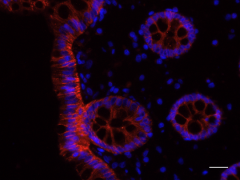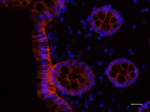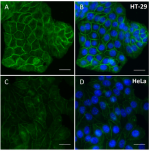- Clone
- W21090A (See other available formats)
- Regulatory Status
- RUO
- Other Names
- Ep-CAM, tumor associated calcium signal transducer 1, epithelial cell surface antigen, epithelial glycoprotein 2, EGP2, adenocarcinoma associated antigen, TROP1
- Isotype
- Rat IgG2a, κ

-

IHC staining using purified anti-CD326 (EpCAM) (clone W21090A) on formalin-fixed paraffin-embedded human colon tissue. Following antigen retrieval using 1X Citrate buffer (Cat. No. 420901), the tissues were incubated with 5 µg/mL of purified anti-CD326 (EpCAM) (W21090A) overnight at 4°C, followed by incubation with 2.5 µg/mL of Alexa Fluor® 647 Goat anti-rat IgG (red) (Cat. No. 405416) for one hour at room temperature. Slide was mounted with ProLong™ Gold Antifade Mountant. Nuclei were counterstained with DAPI (blue) (Cat. No. 422801). The image was captured with a 40X objective. Scale bar: 25 µM -

ICC staining of purified anti-CD326 (EpCAM) (clone W21090A). HT-29 (panels A and B) and HeLa cells (panels C and D) were fixed with ice-cold methanol for 10 minutes and blocked with 5% FBS for 1 hour at room temperature. Cells were then intracellularly stained with 5.0 µg/mL of purified anti-CD326 (EpCAM) (clone W21090A), followed by incubation with 2.5 µg/mL of Alexa Fluor® 488 Goat anti-rat IgG (green) (Cat. No. 405418) for 1 hour at room temperature. Nuclei were counterstained with DAPI (blue) (Cat. No. 422801), and the images were captured with a 40X objective. Scale bar: 25 µM
| Cat # | Size | Price | Quantity Check Availability | ||
|---|---|---|---|---|---|
| 624151 | 25 µg | $170.00 | |||
| 624152 | 100 µg | $430.00 | |||
CD326 is also known as EpCAM (Epithelial cell adhesion molecule), a glycosylated I transmembrane protein containing six disulfide bridges and one THYRO domain. It is highly expressed in bone marrow, colon, lung, and most normal epithelial cells where it functions as an adhesion molecule. In addition to cell adhesion, CD326 is also involved in cellular signaling, cell migration, proliferation, and differentiation. Recently, it has been reported that CD326 expression occurs during the early steps of erythrogenesis. CD326 functions as a homotypic calcium-independent cell adhesion molecule and is involved in carcinogenesis via its ability to induce genes c-myc, e-fabp, and cyclins A & E involved in cellular metabolism and proliferation. Research studies have demonstrated that CD326 plays a role in tumorigenesis and metastasis of carcinomas, therefore, has the potential to serve as a prognostic marker and an immunotherapeutic target.
Product Details
- Verified Reactivity
- Human
- Antibody Type
- Monoclonal
- Host Species
- Rat
- Immunogen
- Extracellular domain of recombinant human CD326 protein
- Formulation
- Phosphate-buffered solution, pH 7.2, containing 0.09% sodium azide
- Preparation
- The antibody was purified by affinity chromatography.
- Concentration
- 0.5 mg/mL
- Storage & Handling
- The antibody solution should be stored undiluted between 2°C and 8°C.
- Application
-
IHC-P - Quality tested
ICC - Verified - Recommended Usage
-
Each lot of this antibody is quality control tested by formalin-fixed paraffin-embedded immunohistochemical staining. For immunohistochemistry, a concentration range of 1.0 - 10.0 µg/mL is suggested. For immunocytochemistry, a concentration range of 1.0 - 5.0 μg/mL is recommended. It is recommended that the reagent be titrated for optimal performance for each application.
- Application Notes
-
This clone does not cross-react with mouse.
For immunocytochemistry (ICC), we recommend using ice-cold methanol fixation.
For immunohistochemistry (IHC-P), the suggested antigen retrieval buffer is citrate buffer (Ca. No. 420901) or Tris-EDTA pH 9.0. - RRID
-
AB_3097236 (BioLegend Cat. No. 624151)
AB_3097236 (BioLegend Cat. No. 624152)
Antigen Details
- Structure
- CD326 is an 314 amino acid protein with a predicted molecular weight of 35 kD
- Distribution
-
Highly expressed in bone marrow, colon, lung, and most normal epithelial cells. Also highly expressed on carcinomas of gastrointestinal origin. Expressed during early erythrogenesis.
- Function
- Homotypic calcium-independent cell adhesion. CD326 is involved in carcinogenesis by its ability to induce genes involved in cellular metabolism and proliferation.
- Interaction
- Monomer. Interacts with phosphorylated CLDN7
- Ligand/Receptor
- LAIR-1 (CD305), LAIR-2 (CD306), Ep-CAM
- Cell Type
- Epithelial cells
- Biology Area
- Cancer Biomarkers, Cell Biology, Cell Proliferation and Viability, Immunology
- Molecular Family
- Adhesion Molecules, CD Molecules
- Antigen References
-
- Strnad J, et al. 1989. Cancer Res. 49:314.
- Munz M, et al. 2004. Oncogene. 23:5748.
- Maetzel D, et al. 2009. Nature Cell Biology. 11:162–71.
- Osta WA, et al. 2004. Cancer Res. 64:5818–24.
- Litvinov SV, et al. 1996. Journal of Pathology. 148:865–75.
- Armstrong A, et al. 1996. Cancer Biology & Therapy. 2:320–6.
- Rao CG, et al. 2005. Int J Oncol. 27:49.
- Gene ID
- 4072 View all products for this Gene ID
- UniProt
- View information about CD326 on UniProt.org
Other Formats
View All CD326 Reagents Request Custom Conjugation| Description | Clone | Applications |
|---|---|---|
| Purified anti-CD326 (EpCAM) | W21090A | IHC-P,ICC |
Compare Data Across All Formats
This data display is provided for general comparisons between formats.
Your actual data may vary due to variations in samples, target cells, instruments and their settings, staining conditions, and other factors.
If you need assistance with selecting the best format contact our expert technical support team.


